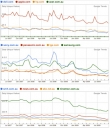
One of my clients attended a Social Media Marketing forum at Deakin University recently. He was surprised just how out of touch most marketing and business managers are with this medium as a means for promoting a business. The questions being asked were about how to control staff access to social media or how to post their brands’ advertising and collateral across the newer platforms.
This top down approach where management dictates the agenda no longer cuts it.
In the same way the Internet has empowered the public to access their news, music and entertainment whenever they want, not when the distributers choose to roll it out, Social Media is taking the online quest for information about products and services away from publishing and brand sites. Social Media is creating a vibrant forum for conversation about products, services and brands beyond the direct control of a company’s sales and marketing force.
The statistics show the rapid pace of change of where people are going online in search of information of all kinds.
Trend away from website visitation to Social Web
Google trends show over the last 2 years a significant decline in visitors to brand and media sites.

Boom in Social Media and content sharing
More people are seeking and sharing what they want online.

It’s no longer enough to have a brochure style website, you can no longer sit back while your salesforce distributes your marketing collateral and your marketing department runs ads telling the masses how good you are.
Everyone in your organisation and every one of your customers is now a prospective advocate for your business. Or they might be saying your competitors are better. You can’t control the conversation, but to compete today you need to formulate a social media strategy, coach your staff, create content of use to customers and prospects and contribute to the conversation in an open and honest way.
Small can succeed in retail against big budget incumbents
Growing up in sixties suburban Sydney the most exotic cuisine my family was familiar with was cabanossi on Jatz crackers. Father felt like a Tooheys or two and good on my mum, she knew Tip Top was the one. Fortunately, forty years of immigrant mothers from around the globe have helped expand Australians’ culinary horizons.
Family businesses show how to be a challenger brand
At the Food and Wine Expo held by Family Business Australia in Sydney in November, the influence of Nonnas was evident as third generation business owners showcased their gourmet products. Their time has come, statistics show the trend to gourmetisation of the Australian shopping basket has now reached beyond the specialist deli and ethnic store to the Supermarket.
Unlike most trade shows, what struck me at the FBA event was the friendly atmosphere, no hard sell, just an infectious enthusiasm for the products these families have been creating for years and a desire to share business stories. From the small catering company making their first tentative step into retail, through to a food service business that gave up on retail in the 70s, one story is common: the bigger challenge isn’t getting onto the shelves of Coles and Woolworths, it’s how to stay there and make a profit.
Two family businesses, Taylors Wines and Coopers Brewery, are testament to the magic ingredient for success in the retail market – the power of building a brand. Branding is what puts the power in your hands, not the channel’s. Building a brand takes more than one-off promotions, or advertising that simply says you are in store now, or paying for inclusion in catalogues with discount offers. To build a brand you need to invest in marketing over time to establish the brand story and your values.
Brand marketing delivers these benefits over a me-to sales approach:
Product
Easy to copy
A commodity
No special distinguishing features
What a factory produces
Shorter life cycle
Addresses functional needs
No identity
Products compete on price
Brand
Hard to copy
What consumers buy
Emotional fit with consumers
Level of confidence and trust
Longer life cycle
Addresses emotional needs
Have personalities
Brand can demand a premium
Fosters Group has destroyed shareholder value to the tune of hundreds of millions of dollars over the last decade by mismanaging the marketing of some icon wine brands, from Lindemans and Penfolds to Seppelt and Tollana. Meanwhile, family business Taylors Wines has stayed true to its five decade history with consistent product, packaging and promotion.
Nick Levy, the marketing manager at Taylors, wouldn’t dream of throwing out the heritage of this family business, whereas corporations time and again allow each new brand manager to make their mark by changing the label their customers know and love to chase a fleeting fashion. Often the new look comes at the expense of long won recognition. Similarly, downgrading a product’s quality to maintain margin or constantly price-cutting to gain share ultimately destroys brands.
Yes, we live in a time where the pace of change is so much faster, yet taking the time to establish what you stand for, developing a dialogue with your customers and creating a sense of authenticity are increasingly valuable tools in a world where global producers can pitch to your retailer with a cheaper knock off product as soon as you leave the buyer’s office.
If you value what you have to sell, it pays to remind your customers as often as you can of why they should love you. Now you can afford to. New technologies, data intelligence and eCommunications now enable challenger brands to compete successfully with the large advertising budgets of corporations.
So find the true benefit of your offer and actively market it. As Revlon said, having built an empire with brand marketing, “we don’t sell cosmetics, we sell hope.” Worked on my mum.
This article first appeared in Business Insight
Leave traditional marketing to your competition... Now there are smarter ways to connect

To make the most of a marketing budget there are now smarter ways to integrate social media and search optimisation.
Many struggle to keep abreast of the changing landscape, while companies that take advantage of 'eCommunication' will benefit from increased efficiencies, decreased costs and improved customer engagement.
Traditional marketing funnel view of prospects...

Medium and message is aligned to where the audience is in the funnel, information is controlled by the brand.
The decision making process in an e-connected era...
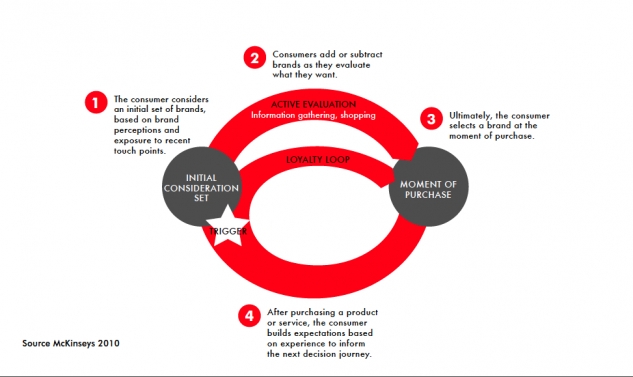
Time to replace the old touchpoints with a new mix
The journey is no longer simply linear, the customer now has control over what they see and read on any subject. The audience enters, leaves and re-enters the decision making process more often, with more access to information from more sources when they want it.
Your eCommunications checklist
Whether your business is B2B or B2C, it’s no longer enough to think in the linear way of out of home, in store (channel), at home. Here is a new set of options which UNO utilise to supersede or integrate with existing programs:

Are you a retailer or publisher, advertiser or educator? The Internet has blurred the lines.
There used to be clear delineations between product manufacturer/creator, channel/distributor, retailer and end consumer.
Enabling this traditional marketing model there was mass media. Advertising mad men then helped consumers to embrace the products and services they hadn’t heard of and didn’t know they needed. Now the interconnections of the Internet have transformed the sequence of commerce and marketing.
Customers are now researching every category online
People have a need? They research online for themselves in the safety of their own home, avoiding the charms of advertisers and brand collateral, packaging and point of sale merchandising. The empowered consumer accessing product knowledge on the web via forums, chatrooms and reviews is beyond the charms of the seasoned salesman on the shop floor.
Even more disconcerting for the traditional retailer of a product or service is the emergence of the medium no longer just being the message, but now a vertically integrated marketing model.
From books to money management, every category has been turned inside out and upside down. What was linear, is now a 3D demand and supply freeform organism.
Consider books. A hard back would come out, early adopters would pay a hefty premium, soft cover would follow, trends would be noted, popular titles would have second and third editions printed and distributed, blockbusters would be advertised and the retailers would rake in the cash and the publishers would cover the costs of the many failures by most of their authors.
Then Amazon cut out the middleman, and now with the Kindle is changing the distance from content to delivery even further, you can now download and store a library of 3500 “books” on a device that is close to the price of a couple of hardbacks. So if there is no need to print and distribute, does the author deal direct with Amazon, seeing the retailer become the publisher?
Even services aren’t untouched by the digital revolution
Take for example Superannuation Funds. If you work you have one, no wonder there are thousands of funds competing for a share of 9% of your salary.
For Australian investors there used to be 3 Clayton’s choices, the choice you have when you don’t get a choice. If you were a blue-collar worker your employer put you into the Industry Super Fund that was created for your industry. If you were a public servant, you were automatically in your government fund. White-collar workers had a modicum of choice, the local Insurance salesman would flog a retail fund and benefit from the handsome commission and trailing fees.
Not any more. Super Choice means most can now choose their fund. Those who are motivated research online, in fact 50.6% do, whereas only 12% turn to newspapers and a mere 3% magazines. So while all those funds are spending hundreds of millions advertising in mass media, savvy investors that are shopping around are stumbling upon a vertically integrated model. Fairfax Digital owns InvestSmart, a licensed financial services business that bought Direct Access, which was a discount retailer of funds. Fairfax in its wealth and business sections publishes articles on super and investment. On the same pages are links and comparison tools branded InvestSmart. These tools and tips and comparison lists educate the Super Shopper. Then when they are ready to buy, fulfillment is just one click away for a fee a fraction of the traditional adviser model. So the publisher becomes the retailer.
So does all of this mean consumers are better off? The fastest growing and the biggest segment by value of the 1.4 trillion dollar Super category is DIY. Self Managed Super offers investors the allure of control. Pity the average SMSF underperforms the average Industry Fund and has higher costs, until someone challenges the model that is.
Whether you are a retailer or a service provider, a financial services business or a manufacturer, it’s now time to reappraise your marketing model before your competition beats you to it.

Marketers have spent the last decade watching Woolworths maintain dominance in grocery while Coles failed to focus on customer needs and treated suppliers with disdain. Under Wesfarmers things are starting to change, yet the biggest fight in retail over the next decade is more likely to be driven by a huge shift to buying online.

While Australia’s Westfield has over 30 years fine-tuned a profitable model to encourage a visit to the Mall, as therapy for the modern empty soul, the Internet is on the cusp of changing the behaviour of society in an equally profound way.
It’s already happening. In 2009 Australians spent $24billion on retail online according to research commissioned by eBay and predicts a 40 percent increase to $32.8billion in 2012.
Australia’s retailers are falling behind the rest of the world in grabbing a share of the online retail spend. "As Australian retailers struggle to build effective online presence, overseas competitors are taking advantage of the gap in the Australian market and are currently taking around 40 per cent of Australia's online retail spend," according to PayPal MD Paul Feller.
"There is a huge opportunity for retailers to capitalise on the growing online marketplace in Australia. In the last six months alone the average consumer spent $1,223 on online shopping, an increase of $130 from the second half of 2009."
So Westfield has to balance an online strategy with keeping footfall high in the malls to keep those retail tenants in biz. No easy task, now that broadband speeds and speed and reliability of delivery through the mail are narrowing the gap between online purchase and the wardrobe.
Who shops online?
My daughter buys most of her clothes online from the US and UK for a fraction of local prices, my son buys his music and sound gear from all corners of the world and Amazon keeps my partner well read. Online purchases of all sorts of items will become the norm, especially as the ways to enhance the shopping experience online grow.
In the past you would see the latest fashions in a magazine spread, be exposed to an ad on TV with Megan Gale for David Jones and go the mall to try it on. Now the whole experience can be completed online. The Ceros platform is being used by the likes of Sears, Tesco, Virgin and IKEA to show product and close a sale using a rich media eMagazine. Have a look. We’re already using it to help our challenger brand clients leave their competition behind.
Read MoreMarketing tips for fund managers
Fund managers can make more money by marketing. The trick is to know what marketing is exactly...
I have a passion for following fund managers’ performance and comparing how they stack up against their investment philosophies. There are a handful of fund managers who stick by their principles and deliver above average results through the ups and downs of the markets. What surprises many managers is that investment doesn’t always come flooding their way when they are doing better than the index. There are plenty of examples where poor performing funds continue to dominate in the competition for FUM.
It’s not enough to rely on BDMs and the distribution and sales channels; every fund is out there building relationships with the instos and advisers. The commercial reality is rooted in human nature; ultimately the salesmen who managers are relying on to recommend a fund will go for the easy sell. And as we’ve seen, performance can’t be the only draw card or there wouldn’t be 19,500 funds on the market where the biggest generally aren’t the best. It would be a mistake to think the end of commissions will result in a rush to quality, inertia and confusion will see to that.
It’s time the better managers tried something new to most in the industry. It’s what’s been honed and crafted by the world’s most successful companies, from Apple to Armani, Mercedes to Mars: it’s marketing. In a world of multiple choices, marketing is one of the few tools that can make a significant contribution to the success of a business.
The financial services industry still confuses sales and distribution for marketing
It isn’t. Marketing takes the ball the first fifty metres and sales kick the goal. Then it’s marketing that continues to remind investors why they made the right decision choosing your fund, so they’ll stick by you through the inevitable bumps and falls. And invest with you again and again.
In the words of Wikipedia, marketing is the process by which companies determine what products or services may be of interest to customers, and the strategy to use in sales, communications and business development. It is an integrated process through which companies create value for customers and build strong customer relationships in order to capture value from customers in return.
Manage the image you create for your brand and how you promote it
From product design and the language you use, your logo and stationery, the look and imagery in brochures and PDSs, the content and design of e-newsletters, what is on your website and how it is presented, to advertising and sales collateral. When every part is working together in a co-ordinated fashion the whole adds far more value to the business than the investment in the parts. And just like investments, managed well marketing delivers compound returns.
Over the years I’ve found integrated marketing works just as well for financial institutions as it does for baked beans. Research by the School of Management and Finance, University of Nottingham showed back in 1998 the similarities emerging even then between consumers’ responses to financial services ads which featured the same cues as ads for fast-moving consumer goods (FMCG) and the influence on subsequent purchase decisions.
Put simply, when it comes to proven ways to make money, fund managers can get a healthy ROI from marketing. For evidence, they just have to ask about the results of my many marketing experiences of 30 years, from banks to baked beans.
Signs of the times... who has the time?
Outdoor advertising is diminishing in effectiveness, like many traditional mediums
Not surprising when you think about the increasing clutter advertising billboards have to compete with for attention.
In the Drive section of the SMH the other day one motoring journo observed: “I went to a suburban shopping district and counted 19 road signs clustered around the first intersection. There were 55 road information messages in about 100 metres. Even when travelling at 40km/h you are left with just nine seconds to read them". In the book Traffic, Tom Vanderbilt states the average driver must process 1340 pieces of information every minute.
So recently when a client asked UNO to review their annual advertising media budget we weren’t too keen to recommend continuing to spend several hundred thousand dollars for one poster above the M4.
Old habits die-hard, the CEO drives to work each day and passes that one sign. We couldn’t convince management that for about 20% of the cost of that one sign they could develop an ongoing relationship with their customers using the latest Web2.0 technologies and build a valuable database for future use.
While traditional media companies like Eye Corp continue to sell posters, a medium that hasn’t changed for a couple of centuries, newer more effective alternatives are emerging. (When the price is right.) ROI marketing starts with understanding the real stats.
Innovation in signage
Recently Ryan Simpson of Val Morgan showed me the latest research on their innovative take on signage, large video screens in shopping centres.
While I always take statistics with a grain of salt, the figures reflect the relationship between clutter and proximity to where the purchase can be made. Despite the amount of billboards, busbacks and taxibacks that shoppers must have passed on their way to the shops, almost 50% say they didn’t notice any advertising. 30% remembered noticing billboards, whereas this new moving screen medium within shopping centres was noticed by over 70% of the 1,000 people surveyed by Nielsen research.
Pity I didn’t have those sorts of stats on hand when I tried to talk that client out of spending a large chunk of their budget on that one sign.
Bigger ad budgets usually mean greater waste
Marketers don't always get what they pay for. I recently met with the new regional head of one to one marketing of a world leading brand. One to one is their fancy term for online. This new manager has been brought in from the USA to determine how the millions of dollars they spend annually in this region can deliver a better return.
Mid size companies can learn from the mistakes of larger marketers with larger budgets. Some of the areas of waste this expert has identified in just a few months are listed here:
Marketing budgets managed within silos is inefficient
Some products have budgets too small to make any impact, while others spend more than necessary because they have a larger allocation. Simply by adding an overview of expenditure across the portfolio would deliver a win win result.
Too many contracts with too many large agencies can drive a big spending approach. Marketing managers with little experience are often given average strategic advice and average creative executions. Large agencies are inclined to overspend on media exposure, (with commissions it's an easy earn).
Set marketing KPIs upfront
Smarter marketers know investing in more management time upfront determining objectives and KPIs, with strategic intellect and strong creative can mean a much smaller media spend can deliver greater impact, more leads and higher conversion rates. There is also an inevitable diminishing return factor from spending more, if someone sees your ad two or three times and still hasn't bought, spending more to show them the same proposition four or five times is simply a waste of money.
There is value in retained knowledge
Years of collected data, research results, campaign learnings and customer databases are often ignored with each new project. Every campaign can and should add incremental value to the next. Take a test and learn approach, rather than a big spending one-off hit. This is one of the fastest ways to implement ROI marketing.
Fortunately for my mid sized clients, I've found over the years insight led creative marketing can punch above it's media weight time and again.
Read MoreGM a victim of launch and leave
For General Motors, big has not proven to be better. From 50% market share to 20% and bankruptcy in just 40 years has partly been blamed on an inability of management to move with the shift from big gas guzzlers to smaller cars. The disastrous purchase of Hummer in 1999 showed how recently GM thought big still had a big future. Time has proven there were only a few big spenders like Renee Rivkin who bought these massive buckets of bolts, obviously not enough to pay the massive borrowing costs.
Less obvious to the public, and of more interest to marketers, are the views being expressed that a lack of advertising support has played a very significant role in the rapid market share loss to the Japanese car makers.
One example was the surprisingly upbeat statements by the head of marketing of GM, he is excited by the prospect of having less brands to support with his marketing budget. With the jettisoning of divisions like Pontiac, he'll be left with just four brands to promote, including Chevrolette and Cadillac. This he trumpets will give him a chance to compete with the same ad budget as Toyota.
In an obituary of the once market leading General Motors, The New York Times blames management for a failure to support it's product with advertising.
Advertising works, The New York Times says so
It points out GM finance staff wrestled with product developers and marketers, thus causing GM to fall victim to a practice called launch and leave - that is, putting product on the market, then failing to support them with advertising.
As someone who has played a part in helping numerous businesses grow share by using smart, creative advertising, this is a particularly public example of the consequences of not believing in the power of marketing. If you ever have to justify to management the wisdom of investing in advertising, when so many accountants seem to view it as a discretionary cost, use this following quote from a past executive of GM who was part of the team that created the successful Pontiac GTO in the 60s and wrote the book about it Glory Days...
Image is everything in building brand equity
Nobody gave any respect to this thing called image, because it wasn't in the business plan. It was about "when is it going to earn a profit?"
As the New York Times points out, over the years the marketing skeptics at GM became practiced at the art of explaining their problems, attributing blame to everyone but themselves.
Read MoreIt pays to trust people with passion
In the last week a visit from a chimney sweep and a conversation with a successful Australian manufacturer reminded me of the value of passion in business.
I was surprised when the chimney sweep asked when was the last time my chimney had been cleaned. Annually didn’t make sense to him judging by what he saw with his fancy mirror... unless I burn 20 tonnes of wood a year, which I don’t. I was quickly impressed by his enthusiastic run down on the finer points of proper chimney maintenance. This man has been cleaning chimneys for 27 years and was still getting a buzz from helping people solve their dirty flue problems, he described the joy solving more difficult challenges and leaving customers with fires that draw like new. His fee was no more than the company that has under serviced us over the last few years.
Whatever service you need, find a practitioner who is passionate about what they do
One of my long standing clients, going on nine years now, makes plantation shutters. Marion Mikkelsen of Open Shutters is passionate about her product, and has built a brand over this time that has proven resilient against the onslaught of cheap Chinese imports. She is so passionate every aspect of her business is constantly reviewed with the objective of constant improvement. She refuses to compromise, so instead of cutting corners to save costs this business runs on a successful program of creative thinking, R&D, staff training and manufacturing innovation.
This passion shows in her product, which my wife thought was the best when she did her pre-purchase research for our home. It was only a few years later I coincidentally won Marion as a client... it is great to be able to market a product you’ve bought yourself.
Why do so many business people mistrust each other?
Over 20 years this pioneer of timber shutters in Australia has led with product innovation and with UNO’s marketing help driven the growth of the category. Yet Marion lamented this week how it’s only after many years her distributors are beginning to trust what she says about her product and her overarching belief in the necessity to fulfill the expectations of consumers. How could so many small business owners not recognise the genuine passion displayed by Marion?
I shouldn’t be surprised, I often find business prospects are cynical of what I have to say about how smart marketing can help their businesses succeed. I’m passionate about what I can do to help people, however it’s even harder to be believed when I work in an industry that the public constantly ranks at the bottom of the trust table alongside used car sales and real estate agents.
Read More
Here are the stats that show why banner ads deliver the lowest ROI in the digital marketing mix.
- Over 5.3 trillion display ads were served to U.S. users last year. (ComScore)
- That’s 1 trillion more than 2009. (ComScore)
- The typical Internet user is served 1,707 banner ads per month. (Comscore)
- Click-through rates are .1 percent. (DoubleClick)
- The 468 x 60 banner has a .04 percent click rate. (DoubleClick)
- An estimated 31 percent of ad impressions can’t be viewed by users. (Comscore)
- The display advertising Lumascape has 318 logos. (Luma Partners)
- 8 percent of Internet users account for 85 percent of clicks. (ComScore)
- Up to 50 percent of clicks on mobile banner ads are accidental. (GoldSpot Media)
- Mobile CPMs are 75 cents. (Kleiner Perkins)
- You’re 471 times more likely to survive a plane crash than click a banner ad. (Solve Media)
- 15 percent of people trust banner ads completely or somewhat, compared to 29 percent for TV ads. (eMarketer)
- 34 percent don’t trust banner ads at all or much, compared to 26 percent for magazine ads. (eMarketer)
- 25-34-year olds see 2,094 banner ads per month. (ComScore)
- 445 different advertisers delivered more than a billion banner ads in 2012. (ComScore)
Put simply, banner ads don't work
Remember these figures next time a media sales rep tries to sell you a banner ad campaign. Even if it’s free it may not be worth the effort, you’re 31 times more likely to win Lotto.
Read More
The A to Z of digital acronyms


Every industry has its acronyms. With this list you will be prepared when dealing with people who speak digital:
AIDA - Attention, Interest, Desire, Action
AJAX - Asynchronous Javascript and XML
API - Application program interface
AOV - Average order value
AR - Augmented reality
ASP - Application service provider
ATD - Agency trading desk
B2B - Business to business
B2C - Business to consumer
CIO- Chief information officer
CLV - Customer lifetime value
CMS - Content management system
CPA - Cost per acquisition / action
CPC - Cost per click
CPL - Cost per lead
CPM - Cost per thousand
CPV - Cost per view (see also PPV)
CR - Conversion rate
CRM - Customer relationship management
CRO - Conversion rate optimisation
CSS - Cascading style sheets
CTA - Call to action
CTR - Click-through rate
CX - Customer experience
DM - Direct mail (or 'Direct message', in Twitter circles)
DMP - Data management platform
DNS - Domain name system
DR - Direct response
DSP - Demand-side platform
ECPM - Effective CPM
EPC - Earnings per click
EPM - Earnings per thousand
ESP - Email service provider
FAQs - Frequently asked questions
FB - Facebook
FBML - Facebook Markup Language
FTP - File transfer protocol
GA - Google Analytics
HIPPO - Highest paid person's opinion
HTML – Hyper Text Markup Language
HTTP - Hyper Text Transfer Protocol
HTTPS - Hyper Text Transfer Protocol Secure
IM - Instant Messaging
IMAP - Internet Message Access Protocol
IP - Intellectual property (or 'Internet Protocol')
IPTV - Internet protocol television
ISP - Internet service provider
KPI - Key performance indicator
LTV - Lifetime value
MoM - Month on month
MLM - Multi-level marketing
MVT - Multivariate testing
OEM - Original equipment manufacturer
OS - Operating system (sometimes this is used for 'open source')
PHP - PHP Hypertext Preprocessor
POP- Point of purchase
POS - Point of sale
PPC - Pay per click
PPL - Pay per lead
PPV - Pay per view
PR – Page rank
PV – Page views
QA - Quality assurance
QR Code - Quick response code
QS - Quality score
RFI - Request for information
RFP - Request for proposal
ROI - Return on investment
RON - Run of network
ROR - Ruby on Rails
ROS - Run of site
RSS - Really Simple Syndication
RT - Retweet
RTB - Real time bidding
RTD - Real time data
S2S - Server to server
SaaS - Software as a service
SEM - Search engine marketing
SEO - Search engine optimisation
SERP - Search engine results page
SLA - Service level agreement
SM - Social media
SME - Small / medium enterprise. (aka SMB = ‘business’)
SMM - Social media marketing
SMO - Social media optimisation
SMP - Social media platform
SMS - Short message service
SOV - Share of voice
SOW - Statement of work
SSL - Secure Sockets Layer
SSP - Supply-side platform
SWOT - Strengths, weaknesses, opportunities, threats
TLD - Top level domain
TOS - Terms of service
UCD - User-centric design
UI - User interface
UGC - User-generated content
URL - Uniform resource locator
USP - Unique selling proposition
UV - Unique visitor
UX - User experience
VOD - Video on demand
VM - Viral marketing
WC – Week commencing
WOMM - Word of mouth marketing
WYSIWYG - What you see is what you get
YOY - Year on year
YTD - Year to date
XML - Extensible Markup Language
I'm sure we've missed a few. Feel free to add your favourites in the comment box.
Where would you advertise if it was YOUR money?

I read recently, most entrepreneurs who are successful focus on realising their business concepts as well and as fast as they can. Worrying about how much money they will make comes a distant second.
Entrepreneurs focus on what the customer needs. The financial rewards follow if they have developed something that truly creates added value for their customers.
The advice industry is different. Advisors focus on what the customer will pay. Financial advisors charge you a percentage of what you have to invest. Not according to how they add value at the end of the financial year, which is what you actually need.
Last year the ASIC mystery shop of 64 financial advisors found only 2 gave “good” advice. 62 gave generic or bad advice, generally in line with their own interests, not the customers. While there’s no regulator doing mystery shopping of ad agencies or media shops, I suspect marketing services “advisors” wouldn’t score much better.
Digital media is commission driven
Media sales is still predominantly based on a cut of what you spend, not a share of your return on investment. Online ad-sales is the same model, just with a bigger margin from your spend. Some online adspace aggregators mark up inventory by 60%. For a 60% markup their computer serving of your ads has very little value add, let alone quality control. Look at this as an example of inappropriate adexchange placement – an ad for the Maquarie Graduate School of Management targeting women:

Every medium is out to convince you that their category is the best way to spend your money. They will always have a pie chart to prove it. It’s in their interest to have you spend more of your marketing pie with them. This will increase their commission, irrespective of whether it will increase your return.
For instance, Google Adwords looks a cheap way to buy eyeballs. But if your Adwords campaigner gets into a bidding war for the most popular keywords, you’ll spend more than the same number of leads from less popular search terms. Does the supplier care?
You might think the answer is to use media specialists who charge by time. Like lawyers, they’ll make more the longer their process drags on. More meetings, less decisions, the bigger your bill.
There are now more types of specialists than ever, each fighting for a bigger share of your budget – SEO, PPC, SEM, online content, online ads, email lists, data analysts, mobile, apps, ambient, ambush, experiential, waterproof stickers on urinals…
Which mediums are actually best for your business challenge?
I recommend looking at where to spend a clients’ money from this perspective:
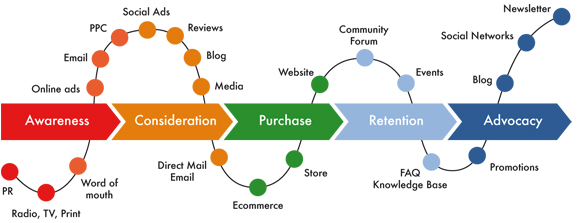
Synergy comes from the right mix, at the right time, with the right creative message. Beware commission driven specialists selling one solution to solve every problem. You’ll get less than you pay for.
Glenn Mabbott
Creative Director & Principal
UNOmarcomms
This article first appeared in AdNews
Read MoreSurvey reveals SMEs fail to measure ROI of online ads
A Yellow Pages survey of 1,800 Australian business owners* has found 69% of small and medium enterprises don’t measure the return on their online ad spend. What’s really surprising in this era of accountability is the finding that only one in 10 base their decisions on where to advertise on the ROI delivered.
What amazes me is the disconnect between business owners increasing desire to do more with less and the missed opportunities these findings reveal.
Advertisers keep telling me they love advertising online because it’s so much cheaper than traditional media. It might be cheaper to buy an adword campaign than a press ad, but are they getting a better return from those clicks?
Do you know which half of your advertising works?
The age-old saying “I know only half my advertising works, if only I knew which half” is just as true of online ad spending as off. The good news is it’s much easier to measure ROI of online marketing than the kinds of activities you used in the past. New technology makes it possible to know what works online and why. Business Intelligence means your spending can truly become an investment with predictable returns.
So if you count yourself amongst the majority of SMEs that don’t have a digital business strategy, maybe you should make it a priority to develop one. After all, there aren’t many things you can do so quickly and effectively that will leave the majority of your competitors behind.
How to measure your marketing ROI
New technologies have also made it much easier to track the performance of your offline advertising and promotion activities. We recently completed another test market campaign for an FMCG customer. In the past it was only major brands that could afford to put in place the kinds of tools needed to measure the ROI of integrated campaigns. Today even challenger brands can track the performance of programs that largely use traditional media because online research, scan data, real time field force reporting and analytics tools are no longer cost prohibitive.
The test and learn approach we have taken with this brand over the last few years has helped lift them above the pack. From being one of half a dozen small players competing for share against a long established multinational, our client is now a clear number 2 in their category. Do you know how much of your marcomms budget is working? There are no excuses because now you can.
* Survey published December 2010


"There are known knowns; there are things we know we know.
We also know there are known unknowns; that is to say, we know there are some things we do not know.
But there are also unknown unknowns – the ones we don’t know we don’t know."
While you may not like his politics, this famous quote from Donald Rumsfeld preceding the US invasion of Iraq perfectly sums up the dilemma faced by business owners today.
People are punch drunk from 5 years of relentless financial destruction of the world’s capital markets. Meanwhile, technology, and especially the digitisation of the world, has seen the pace of change of commerce reach incomprehensible pace. Is it any wonder business managers are floundering?
Challenger brands are making the most of this time of change to gain an advantage over competitors
Many business owners still think they can wait things out until things return to “normal.” What they don't know is the new model for success demands the ability to try new things, quickly and often.
Renee Todres heads a team of digital specialists at Tipping Point that have been helping businesses transform often complex transactions with their customers into simple ones. From BT to Elle Bache, once complicated business processes are being replaced with simple, intuitive interactions that make customers feel in control. Renee makes a wonderful observation –
"to learn you need to listen to yourself less."
Tipping Points approach is to add value by finding new insights. One way to succeed today is to recognise the limitations of your known knowns. Then seek out specialists that can help you discover the unknown unknowns. Get to know the ones that can help improve your position against your competition. And have the confidence to act on those new insights knowing the biggest threat to businesses today is business as usual. The Aussie attitude that she’ll be right now almost certainly guarantees failure.
I'm not suggesting spending all your energies on research. We’ve all seen managers fall into the paralysis by over-analysis trap. Too much data can actually hinder making effective business decisions. According to IBM’s 2012 global survey of 1700 CEOs, asking customers what matters to them is now more useful than financial analysis.
"Of course we need information and insight, but what we need most is the capability to act on it."
Unit head, Government, Hong Kong
In the words of Boston Consulting, today in business “the spoils go to the nimble.” We have found our challenger brand clients are winning by trying new and interesting things, fast and often. In the past you needed big budgets and big balls to try something different. There are now technologies that allow marketers to test new strategies while limiting financial risks.
As Renee and other niche specialists have shown me, it’s surprising how much there is to know that the big brands don’t, simply because they aren't looking.
Read MoreAll those for firing the Marketing Managers? Any against?


When they leave the office for the holidays, many marketing managers won’t realise their role may be restructured out of existence in the New Year. Over the Christmas break, CEOs around the country will be re-appraising who is an expendable cost to the business, versus who is an income generator.
Who will defend so many marketing managers when the case that has been building against them throughout 2012 is so strong?
Here is my snapshot of some of the evidence CEOs may be considering as they weigh up whether to fire their marketing managers:
Evidence A
Many of the tasks that CEOs thought only marketing managers could do can now be Googled. From 99 Designs to freelancer.com any CEO can buy marketing stuff cheap. Whether it’s designing websites or mailers, SEO or adwords, printing or promotions, everything is just a keyword search away. Who cares if you don’t know which half of your advertising works now you can buy it direct at third world prices?
Evidence B
According to this year's Roy Morgan annual professions ranking, marketers have failed again to rise much above used car salesmen. What CEO wants someone with less credibility than a real estate agent on their team? Consider this evidence alongside the growth in Australia of the casual workforce and outsourcing generally.
If you must have a marketing manager, why not buy by the hour, save on fixed and overhead costs.
Evidence C
CEOs have never believed marketers anyway. Fornaise regional survey of CEOs in 2011 found 75% did not value marketing managers opinions at a board level. In July this year the number had increased to 80%.
In November a follow up survey found seven in 10 CEOs hold themselves "somewhat responsible" for marketers’ poor perceived business performance because they have given up on holding their marketing managers accountable. CEOs gave up measuring the performance of their marketing managers. If it isn’t measurable, it won’t be long before the accountants decide marketing managers are an expensive indulgence a lean 21st century business can do without.
Evidence D
Business confidence is at it’s lowest level for four years. More companies went out of business in Australia in the last quarter than any other.
"She’ll be right" is now more wrong than ever. CEOs will have to change the way their business operates to survive. If they don’t know what marketing managers do, it’s an easy place for them to start cutting. As AdNews reported, one recruiter said recently, “companies want to hire revenue generators, and see marketers as passengers not drivers.“
Evidence E
How many CEOs actually know what marketing is? Consider one of the 4 Ps of marketing, price. In the FMCG industry, paying a rebate to Woolworths for a price promotion is still considered a marketing investment, not the sales tool it is.
Evidence F
Consider the other 3 Ps as they apply to businesses today. When do CEOs involve marketing managers in product development, or distribution innovation, or the building of a Business Intelligence driven CRM program? These new silos now fall under Strategy and Innovation Manager or the Supply Chain and Technology Integration Manager or the Chief Information Officer.
Is there a case for marketing managers?
The evidence doesn’t look good if the CEO doesn’t realise marketing managers can add value by thinking across silos. enabling the parts to work in synergy.
The Fornaise study found CEOs “think marketers have continuously failed to unquestionably and consistently prove in the boardroom that their marketing strategies, activities and campaigns generated actual business growth.”
To grow today you have to become a successful challenger brand. To be relevant today marketers have to champion at the board level the power of marketing to create a challenger brand.
If marketers aren’t in the boardroom, either the accountants, the salesmen, even the IT department will contend they need more of the budget to grow the business. Why not take it from the marketing pot, it’s just an artsy fartsy waste of money after all? Isn’t it?
12 days of vintage Christmas ads

Have you heard about the uproar surrounding the latest 'sexist' Christmas ad for ASDA in the UK? Here's your chance in case you missed it.
It seems that history is repeating? Here's a fun look at UNO's 12 days of vintage Christmas ads. They certainly gave us a few laughs!
On the 1st day: What more could a girl ask for?!

On the 2nd day: Should you be tempted to over indulge...

On the 3rd day: What could it be?

On the 4th day: It's the thought that counts!

On the 5th day: The perfect stocking filler!

On the 6th day: Foam filled fun for all the family!

On the 7th day: Taking care of Christmas!

On the 8th day: A shame they didn't make them for dogs too?

On the 9th day: Say it with... spoons?
On the 10th day: We all know that Santa wears red and white because...
On the 11th day: We're sure ASDA would approve!

On the 12th day: Relax in the comfort of your own home
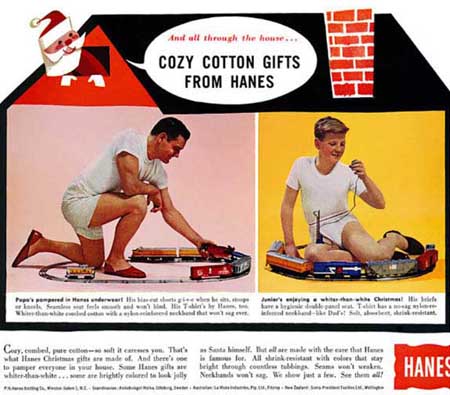
Oh what the heck! One more!
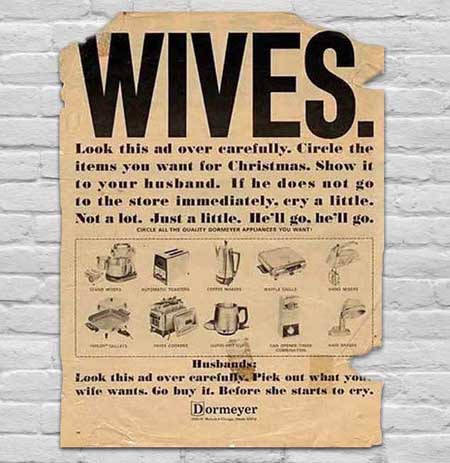
Big businesses' loss can be your gain


In the last few weeks business owners have been warned by the head of one of Australia’s biggest mining corporations that if we don’t change our business models we will die.
So who do business owners turn to for advice? In AdNews the marketing head of one of the big 4 banks reveals agencies don’t get digital. And the CEO of one of the biggest media planners in the country said "anyone in the media industry who claims they know what is happening is lying."
How many consultants does it take to change a light bulb?
Too late, fibre optics and LEDs have changed the market.
Every manager who has grown a business understands the value of seeking advice from specialists, you can’t be an expert at everything. Today we have the added problem that most so-called experts learnt their skills pre-Internet. Most business coaches are dinosaurs, as the world of commerce changes at ever increasing pace, conventional methods won’t save your business if the customer has evolved to a new way of life.
Think biz is tough? It’s even tougher for big businesses
Don’t panic. Unless you are number 1 in your category, you have less to lose by changing the way you play to fit in with the new rules that are being written by the customer. If you are a mid sized business today you have an advantage that in the past was a handicap. Yes, smaller is more nimble. Big businesses with big investments in infrastructure, systems and sunk costs can’t easily re-invent themselves. Think of all those silos of managers in big companies who have to hang in there for another 5 years because their super was decimated. They are a dead weight that slows down change.
Companies falling out of the top 3 in a given year:

Market share leaders that are the profitability leaders:

Forget the past, where’s the future profit coming from?
Most likely from something you are good at now, but not focused on. If you are a mid market player and still in business, you obviously have enough retained knowledge to draw on. Here are some examples of where UNO's clients have found profit opportunities:
- For a manufacturer it was cutting out the wholesalers.
- For a premium winemaker it is leaving Coles and Woollies to the major brands and growing high margin club membership.
- For a financial services B2B supplier it is repackaging bite-sized insights for the consumer market.
Today more than ever, get to know those who know
What you most need now is a trusted advisor who can draw upon a network of today’s specialists. To grow today, you need to re-invent your model, refresh your offer and relaunch by integrating traditional and new ways to market.
Forget incremental improvements. A few percent saved on input costs and a couple more from efficiency gains won’t save you when the competition pockets a whopping 30%+ of margin by removing an entire step in the route to market.
There’s an idea. Better to do it now, or be done over?
For a better career, get a life as a sponge


Many people in marketing seem to think they are judged on what they will do this week, while many managers think it’s about avoiding mistakes by doing very little. Rather than worry about what others may think of your actions/inactions in the short term, a recent conversation with a self-made squillionare reminded me of what it takes to become successful in business life. It’s not about you – soak up other people’s experiences.
Curiosity is the key
This founder of many businesses was as keen to ask questions about my challenges, as I was to learn about his successes.
Creative people continue to take the passive role of waiting for a brief, hoping the application of their current skills to their next project will bring the recognition they deserve. Meanwhile marketing managers act like thought police, determined to minimise all risks on their watch. So the brief ends up something like this: do something safe, measurable (as in lets make sure there are no nasty surprises), something a bit like someone else has already done, and all for less than it cost last time. This lack of desire to explore the unknown is killing creativity in Australia. Yet it’s creativity that builds wealth. Avoiding risk guarantees smaller returns, or none at all. Cutting margins does not create wealth, it just means you’ll spend your way to mediocrity a bit slower.
Today for a business to thrive it has to be a challenger brand. That’s an old company doing things in a different way, or a new one doing new and interesting things. Being a challenger is not about fine-tuning or polishing what you’ve always done. A business that’s in a well-worn smooth groove, just like a career, soon discovers it’s actually in a rut, going the wrong way. New isn’t always better, but better is always new.
If you’re curious to know what it takes to be better at what you do, you’ll do better than your peers. Curiousity, the squillionare says in one of his many books, is what it takes to succeed. It’s more than just appreciating that you don’t know everything. It’s wanting to know what Donald Rumsfeld memorably described as “the unknown unknowns.” Rather than selectively listening to those around you that you feel comfortable with, avoid making bad decisions by seeking out the wisdom beyond your network.
If you’re an art director, it’s time you hung around with some media gurus, marketing managers with entrepreneurs, accountants with digital user experience designers. Innovation after all comes from outside an industry, it’s not found fiddling around with what your category already does. And today if you don’t innovate you and the business will die.
I’ve often explained my life as that of a sponge. From childhood I wanted to know everything about everything. As I’ve met people with passions for things I know nothing about I’ve soaked up drops of wisdom. You’d be surprised what lateral connections from my sodden sponge can draw just the right drop, at the right time, to create an innovative answer. Whatever your role or experience, take every opportunity to learn from others. It helps to be open about your ignorance in front of experts. I’m always asking the silly questions. I usually find if they really are experts, they will gladly share their wisdom. Soak it up.
What's more important to CEOs - financial analysis, or customer insight?


We now work in a world awash with data. But too much data can actually hinder making effective business decisions. According to IBM’s 2012 global survey of 1700 CEOs, asking customers what matters to them is now more useful than financial analysis.
"This is now a continuous feedback kind of world, and we need the organizational nimbleness to respond."
CEO, Financial Markets, USA
"Of course we need information and insight, but what we need most is the capability to act on it."
Unit head, Government, Hong Kong
So how can you get to know your customers better? While there is no substitute for face-to-face, the survey found CEOs of outperforming businesses believe social media is the next best way to gather insights. More importantly, these insights are helping them take action.
In the words of Boston Consulting, today in business "the spoils go to the nimble."






Scan the QR code for our contact details.
Download the Neoreader app.
© COPYRIGHT 2013 UNO marcomms Privacy